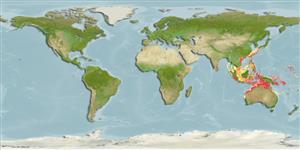أشلاق (القروش و الشفانين) (sharks and rays) >
Myliobatiformes (Stingrays) >
Dasyatidae (Stingrays) > Neotrygoninae
Etymology: australiae: Name referring to the Australasian distribution of this member of bluespotted mask ray complex.
of the genus Neotrygon.
Environment: milieu / climate zone / depth range / distribution range
البيئة
بحري القاع; نطاق العمق 23 - 91 m (Ref. 116741). Tropical
Eastern Indian Ocean to Western Pacific: Australia, Papua New Guinea and Indonesia.
الحجم / وزن / العمر
Maturity: Lm ? range ? - ? cm
Max length : 41.0 cm WD ذكر/ مختلط الجنس; (Ref. 116741); 45.2 cm WD (female)
وصف مختصر
مفاتيح التعريف | الوصف الخارجي | قياسات المظهر الخارجي
This species of the kuhlii-complex (reaching at least 45 cm DW; males maturing at ca. 28 cm DW) is distinguished by the following set of characters: disc is much broader than long, width 1.2-1.3 times length; pectoral apices are narrowly angular; snout fleshy, broadly rounded to weakly angular, with angle 101-103°, length 1.6-2.1 times interorbital width; maximum width relatively well back on disc, length from snout tip to pectoral-fin insertion 1.7-1.8 times and disc width 2.3-2.5 times horizontal distance from snout tip to maximum disc width; preoral length 1.8-2.3 times the mouth width; internasal distance 1.3-1.6 in prenasal length; interspiracular distance 14-16% DW; nostril length 3.4-4% DW; nasal curtain width 8.4-9.1% DW; with small mouth, width 6.5-7.3% DW; horizontal distance from cloaca to the caudal sting base 42-52% of disc length; with thornlets in nuchal and lumbar regions in large individuals, none from tail in all sizes; no dermal denticles entirely from body; pectoral-fin radials 105-113; total vertebral centra (including synarcual) 129-134, trunk centra (including synarcual) 37-41; with large blue spots, the largest spot on disc 0.7-1.2 times eye width; 2-17 (mean 9.4) blue spots on medial belt, largest 3.3-5.6% DW; mask-like marking subtle, usually lightly covered with dark peppery spots (dark spots not widespread over central disc); the ventral surface of disc with distinct dark greyish brown submarginal bands; ventral tail fold is almost entirely dark (Ref. 116741).
A demersal fish found inshore to mid-continental ad insular shelves (Ref. 114953). Found over and adjacent to rocky and coral reefs from shallow water to at least 91 m depth (Ref. 116741).
Life cycle and mating behavior
النضج | التكاثر | وضع البيض | بيض | الخصوبة | Larvae
Last, P.R., White, W.T. and B. Séret, 2016. Taxonomic status of maskrays of the Neotrygon kuhlii species complex (Myliobatoidei: Dasyatidae) with the description of three new species from the Indo-West Pacific. Zootaxa 4083(4):533-561. (Ref. 116741)
IUCN Red List Status (Ref. 130435: Version 2024-2)
استخدامات بشرية
أدوات
تقارير خاصة
Download XML
مصادر علي الأنترنت
Estimates based on models
Phylogenetic diversity index (Ref.
82804): PD
50 = 0.5039 [Uniqueness, from 0.5 = low to 2.0 = high].
Bayesian length-weight: a=0.01096 (0.00350 - 0.03435), b=3.12 (2.87 - 3.37), in cm total length, based on LWR estimates for this (Sub)family-body shape (Ref.
93245).
مستوى غذائي (Ref.
69278): 3.4 ±0.3 se; based on size and trophs of closest relatives
Fishing Vulnerability (Ref.
59153): Moderate vulnerability (40 of 100).
